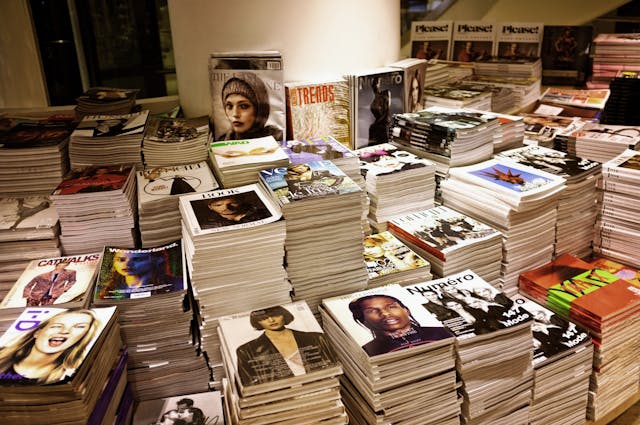Discover the most popular magazines in the 1990s that defined a generation, shaped culture, and changed how we consumed content.
I keep coming back to this thing about popular magazines in the 1990s. Like, why do I still have a stack of old Sassy issues in my closet? Why can’t I throw away that water-damaged Wired from ’95 with the cyber-neon cover that probably gave me nightmares?
Maybe it’s because they were… I don’t know. Different? God, that sounds so basic. But hear me out.
What You'll Discover:
Before Everything Got Infinite (And Terrible?)
The thing is, back then we didn’t have everything. We had something. And that something came once a month, or once a week if you were fancy enough for Time or desperate enough for People.
You couldn’t just google “what does Kurt Cobain think about fame” at 2 AM. You had to wait for Rolling Stone to maybe, possibly, if you were lucky, get an interview. And when they did? You read every single word. Twice. You memorized the pull quotes.
I’m romanticizing this, aren’t I? Maybe the scarcity was actually… bad? Maybe having to wait three months to find out if your favorite band broke up was cruel, not character-building.
But I swear there was something about the weight of those magazines. Literal weight. Physical weight. The popular magazines in the 1990s had substance, you couldn’t scroll past a bad article, you had to live with it, flip through it, maybe even, this is embarrassing, tear it out and tape it to your wall.
The Big Ones (That Everyone Pretends They Remember Better Than They Do)
Rolling Stone: Cool But Trying Too Hard?
Rolling Stone in the 90s was like that friend who was definitely cooler than you but also kind of exhausting to be around. One month they’d have this incredible piece about Tupac that made you cry, and the next month it was some bloated 8,000-word thing about a jam band you’d never heard of.
Wait, no. That’s not fair. They were doing real work. The political stuff, the culture war pieces, that mattered. But also… did they kind of lose their edge? Like, were they too establishment by then? I can’t decide.
Hunter S. Thompson was still writing for them, so how establishment could they be? But then again, they were also doing these glossy celebrity profiles that felt more Vanity Fair than underground journalism.
I’m contradicting myself. Whatever. They were important.
Vogue: Beautiful and Terrible
Anna Wintour’s Vogue was simultaneously the most gorgeous thing you’d ever seen and also probably responsible for your eating disorder. Sorry, is that too real?
But seriously, those Kate Moss editorials were art. Steven Meisel photography that made you believe in magic. And then right next to it, some article about how to lose ten pounds in two weeks that probably should have come with a warning label.
The supermodel thing though? That was real. Naomi, Linda, Christy, they weren’t just pretty faces, they were brands before we knew what that meant. They had personalities. They had opinions. When’s the last time you could name a current model who wasn’t a Kardashian?
Actually, don’t answer that. I probably sound like someone’s dad complaining about “music these days.”
Time and Newsweek: When News Had Gravity
Here’s what’s weird: I used to actually finish these magazines. Cover to cover. Even the boring economic policy stuff. Even the letters to the editor from angry people in Nebraska.
Was I smarter then? More patient? Or was the world just… smaller? More containable?
I remember the O.J. coverage. The Clinton impeachment. Y2K panic (which, let’s be honest, was mostly media-manufactured hysteria, but we ate it up). These magazines made you feel like you understood what was happening. Like you were informed.
Now I get my news from Twitter threads and I’m constantly anxious and never sure if anything is true.
This is definitely romanticizing.
The Weird Ones (That Probably Saved My Life)
Sassy: My First Feminist Education
If you didn’t read Sassy, I don’t know how to explain to you what it was like to be a teenage girl and finally see yourself reflected in media that didn’t think you were stupid.
Seventeen was telling you how to get boys to like you. YM was… okay, YM was also telling you how to get boys to like you, but with more quizzes. Sassy was telling you that maybe the boys could like you for who you actually were, or maybe you didn’t need boys to like you at all.
Revolutionary stuff for 1993.
They talked about depression. About sex without shame. About politics without condescension. The writing was smart and funny and weird in a way that felt dangerous.
And then it died. Because good things always die.
Actually, it didn’t just die, it got bought out and turned into something sanitized and boring. Which is maybe worse than dying? I haven’t decided.
The Source: Before Hip-Hop Got Corporate
The Source was everything. If you cared about hip-hop, and if you were alive in the 90s and had functioning ears, you cared about hip-hop, this was your bible.
The 5-mic review system was sacred. Getting 5 mics meant something. It meant your album was perfect, or close enough to perfect that it didn’t matter.
But here’s the thing I’m realizing as I think about this: was it actually better journalism, or was I just younger and more impressionable? Because looking back, some of those articles were… kind of messy? The East Coast/West Coast coverage got pretty irresponsible toward the end.
But maybe that messiness was part of what made it real? Like, it wasn’t trying to be objective NPR analysis. It was passionate and biased and alive.
I miss that energy. Even when it was wrong, it cared.
Wired: The Future, Designed by People on Drugs
Wired launched in ’93 and immediately looked like it was beamed in from 2020. Those neon page spreads that hurt your eyes? The typography that seemed to be vibrating? The essays about how the internet was going to save democracy and also destroy everything we held dear?
It was prophetic and completely wrong at the same time.
They predicted the digital revolution. They also thought we’d all be living in virtual reality by 2000, so… 50/50?
But reading Wired made you feel like you were part of something. Like you were ahead of the curve. It was one of those popular magazines in the 1990s that made you feel like you understood the future better than your parents did.
Spoiler alert: none of us understood anything.
The Gossip Industrial Complex
People: Your Weekly Dose of Schadenfreude
People was junk food for your brain, and I mean that in the best possible way. It was celebrity worship and human interest stories and “they’re just like us!” photo spreads that made you feel better about your own mundane life.
The “Sexiest Man Alive” issue was an event. We cared about this stuff! We had opinions about whether Denzel Washington deserved it! (He did.)
But also… was it contributing to our obsession with celebrity culture in ways that would eventually metastasize into social media stalking and parasocial relationships and whatever’s happening with influencers now?
Probably. But also, sometimes you just wanted to know what Jennifer Aniston’s workout routine was. Is that so wrong?
Entertainment Weekly: Embracing the Guilty Pleasure
EW understood something that took the rest of media years to figure out: pop culture matters, and pretending it doesn’t makes you look like a snob.
They covered Buffy the Vampire Slayer with the same seriousness as The Sopranos. They understood that sometimes Clueless was more culturally significant than whatever won the Oscar that year.
Their reviews were smart but not pretentious. They got that entertainment could be meaningful without being Important with a capital I.
I still miss their year-end lists. Remember when year-end lists felt special instead of just SEO content?
Teen Magazines: The Identity Factory
This is where it gets complicated. Because the popular magazines in the 1990s that targeted teens were simultaneously empowering and toxic, revolutionary and regressive, meaningful and completely vapid.
Seventeen taught you how to do job interviews and also how to hide your “flaws” with concealer. YM had surprisingly frank sex advice and also promoted crash diets. Teen People covered serious social issues and also ranked celebrities by their cuteness level.
But here’s what I keep coming back to: they made you feel less alone. The reader mail sections were like proto-social media. People shared their stories, their problems, their victories. It was community in print form.
Was it perfect? God, no. Did it help? I think so. Maybe.
I don’t know. I’m still figuring it out.
The Men’s Magazines (And Their Complicated Legacy)
Playboy in the ’90s was this weird cultural artifact, like, everyone knew it was supposedly about the articles, and the articles were genuinely good, but also… come on. We all knew what it was really about.
But Margaret Atwood did publish in Playboy. So did Kurt Vonnegut. So maybe the highbrow literary stuff was real, not just a joke?
Esquire and GQ were doing something interesting with masculinity, showing men that it was okay to care about style, to read fiction, to have feelings. That seems important, looking back.
Or maybe I’m giving them too much credit. Maybe they were just selling products and happened to do it with better writing.
Why I Can’t Let Go
Here’s what I think I’m really trying to figure out: were these magazines actually better, or am I just nostalgic for being young?
Because there’s definitely something to be said for the editing. For the curation. For the fact that someone decided what you were going to read instead of an algorithm deciding what would keep you scrolling longest.
But also, looking back at popular magazines in the 1990s, the magazine world was pretty white. Pretty straight. Pretty limited in a lot of ways that we’re only now starting to understand.
So maybe what I’m missing isn’t the magazines themselves, but the feeling of discovery they gave you. The sense that you were part of something. The physical ritual of reading something beginning to end.
Or maybe I just miss being fifteen and thinking that the right magazine could tell you who you were supposed to be.
Either way, I’m keeping that stack of Sassy issues. Just in case.
What I Think I Learned (But Might Be Wrong About)
- Magazines shaped identity in ways we’re still unpacking
- The scarcity created value, but also gatekeeping
- The writing was often better, but the perspective was often narrower
- They built communities, but exclusive ones
- The editing process created coherence, but also limitation
- Physical media forced commitment in ways digital doesn’t
- Nostalgia is a hell of a drug
I don’t have conclusions. Just questions and a storage unit full of old magazines I can’t seem to throw away.
Maybe that’s enough.





